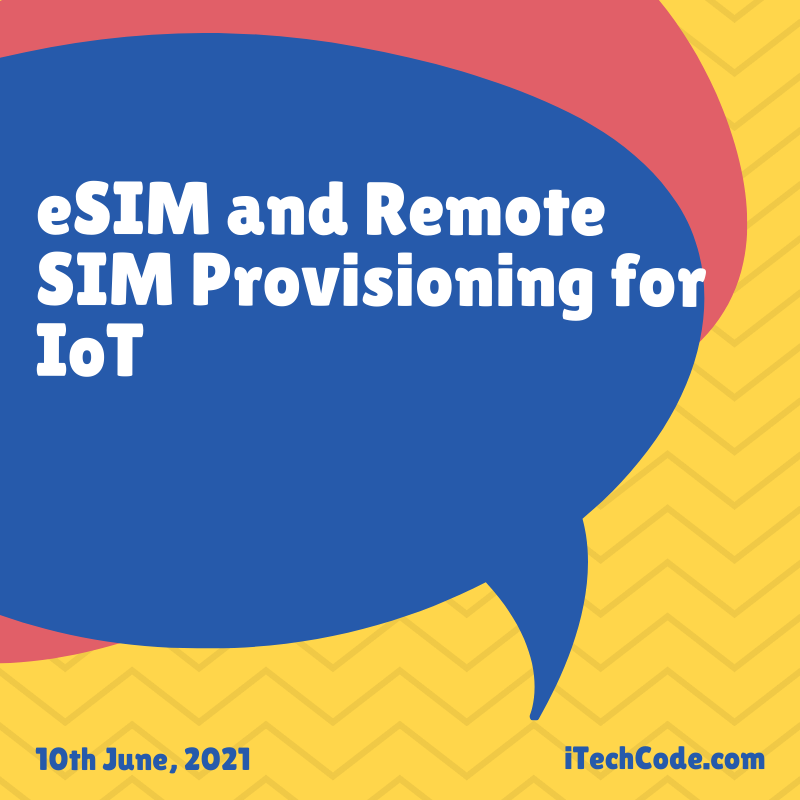The Internet of Things (IoT) is no longer a mere concept, but a reality with tens of billions of interconnected IoT devices all around the world. There are more than 35 billion connected IoT devices in 2020, and the number is still expected to grow and reach 83 billion devices by 2024.
The thing is, the majority of these billions of devices rely on cellular IoT connectivity, and while cellular connectivity does have its perks, there are also some very prominent issues.
One of the key issues, especially in cellular connectivity that relies on true traditional SIM cards, is that switching between different networks will require us to also physically replace the SIM card, which can be a major hassle in an IoT deployment. Think about it, if an IoT sensor is deployed in a remote, hard-to-reach area, replacing the SIM card can be extremely difficult and costly.
This is where the eSIM technology with its Remote SIM Provisioning (RSP) capability comes in.
What Is an eSIM?
SIM stands for Subscriber Identity Module (or Subscriber Identification Module), which is an IC chip that contains identity information for subscribers of a cellular network. A SIM enables a cellular provider to identify its subscriber, figure out which plan this subscriber is subscribed to, and provide service.
As we know, SIM traditionally comes in the form of a removable plastic card in different form factors (macro, nano) that should be inserted into a device’s SIM card tray.
An eSIM stands for embedded SIM and is technically a form factor of a SIM. As the name suggests, however, it is now embedded (soldered) to the device’s body and is no longer replaceable.
This new form factor design of the eSIM offers several unique benefits that are not available in traditional SIM cards:
- It eliminates various logistical hassles of the physical SIM card, like using your SIM card ejector when you need one, or waiting for a replacement SIM card to be delivered by mail in the event of a lost or broken SIM card.
- Since it is embedded within the device, you simply won’t lose an eSIM.
- When your device is stolen, you can remotely deactivate the eSIM and the thief won’t be able to use the device (and access your data)
- It is protected by the device’s body, so an eSIM is much more durable than a traditional SIM.
However, arguably the biggest benefit of the eSIM is the Remote SIM Provisioning feature, allowing us to switch between different cellular providers seamlessly and remotely.
What Is Remote SIM Provisioning?
Remote SIM Provisioning, or RSP, is a feature of an eSIM, which allows secure management of network operation remotely with over-the-air commands.
In practice, RSP allows an eSIM to download and store SIM data from various network providers in the rewritable eSIM.
To put it into context, the standard SIM card we use in our smartphone can typically only store one SIM information from a single network provider. Meaning, if we want to switch to another network provider, we will need to purchase a new SIM card from the respective provider and physically replace the SIM card.
This can be a major logistical issue in large-scale IoT deployments, especially when the devices are deployed in hard-to-reach, remote areas with harsh environments. eSIM and Remote SIM Provisioning eliminate this issue by allowing us to easily switch between networks without physically replacing the SIM card.
By partnering with a proper IoT SIM card partner, you can make the most of your eSIM and RSP by getting the following benefits:
- Versatility: the eSIM is remotely programmable, so we can integrate eSIM apps for various functionalities like network monitoring, authentication, and remote management.
- Single-user interface: with the right IoT data plan, you’ll get a centralized management platform that enables us to monitor all the interconnected devices’ activities with real-time diagnostics and reports.
- Multi-network connectivity: you can easily switch between different network providers remotely, as well as allowing an IoT device to have more than one network provider to ensure reliability.
Benefits of eSIM and Remote SIM Provisioning for IoT Projects
A key advantage of Remote SIM Provisioning in eSIM technology is the ability for IoT operators to easily switch between different network operators remotely. We don’t need to touch the deployed device and physically replace the SIM card with each network change.
In turn, this provides three core benefits in IoT implementations:
- Global IoT Connectivity
If you plan to scale your IoT deployment to a bigger scale, eSIM and Remote SIM provisioning can play a very significant role in facilitating international or even global IoT connectivity. Service providers like Truphone for Things offer reliable coverage in more than 100 countries with Remote SIM Provisioning capabilities.
- Durability and Longevity
Since the eSIM is embedded into the device and is protected by the device’s body, it is much more durable than a standard SIM.
Durability can be a very important issue in many IoT projects where devices are often deployed in remote areas with harsh environments (extreme temperatures, etc.). The eSIM is designed to be more durable and can last for up to a decade even in these extreme conditions.
- Smaller Device Size
The eSIM technology allows us to eliminate the SIM card tray, which provides us with more versatility in designing a smaller device, and manufactures can also use the space to accommodate other components like a bigger battery or another sensor.
Conclusion
eSIM and Remote SIM Provisioning (RSP) are the answer to the various demands of today’s IoT projects, especially for large-scale IoT deployments that require international or even global network coverage.

You can also stay updated by subscribing to iTechCode.